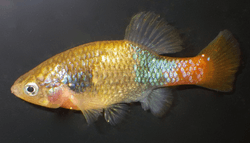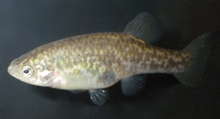Redtail splitfin
| Redtail splitfin | |
|---|---|
 | |
| Scientific classification | |
| Kingdom: | Animalia |
| Phylum: | Chordata |
| Class: | Actinopterygii |
| Order: | Cyprinodontiformes |
| Family: | Goodeidae |
| Genus: | Xenotoca |
| Species: | X. eiseni |
| Binomial name | |
| Xenotoca eiseni (Rutter, 1896) | |
The redtail splitfin, or redtail goodeid, (Xenotoca eiseni) is a species of goodeid fish from the family Goodeidae and subfamily Goodeinae. Like other members of Goodeinae, the redtail splitfin is a livebearer. However, the goodeid mating system differs in several ways from the more common livebearing fish from the family Poeciliidae that includes guppies and swordtails. While no goodeid species is a very popular aquarium fish, the redtail splitfin is one of the most popular.
Range and habitat
The redtail splitfin comes from several rivers in the highlands of Mexico, including the Rio San Leonel and Rio Grande de Santiago in Nayarit and the Rio Tamazula in Jalisco.[1][2] They live in clear mountain streams as well as roadside ditches.[1]
Description
The redtail splitfin is a deep-bodied fish, and males have a hump behind the head.[3] The hump gets larger as the males get older.[2] Males' body color is blue, and the caudal fin (tail) and penduncular area are red or orange.[3] There are a number of color variations, and fish from Nayarit have a bluer body, while fish from San Marcos, Jalisco are blotched. Females are more plainly colored[1] Females are generally slightly larger than males. Females grow to 7 centimeters (2.8 inches) while males grow to 6 centimeters (2.4 inches).[2][4]
Breeding

Male goodeids like the redtail splitfin have a notched anal fin that gives the fish the name "splitfin", instead of the gonopodium of poeciliids.[5] This notched anal fin, or andropodium, is used to transmit sperm to the female. The female nourishes the unborn young via trophotaeniae, which function like an umbilical cord in mammals.[5][6]
Females give birth about every 2 months to 10 to 50 fry.[1] The newborn redtail splitfin fry are relatively large compared to most newborn livebearer fry, at about 15 millimeters (2/3 of an inch) long.[1]
In the wild, both male and female redtail splitfins prefer to mate with fish of similar size. This limits the sexual advantage to males that grow especially large. This minimizes the sexual dimorphism in the size of the fish between males and females.[7]
Aquarium keeping
The redtail splitfin is not a very common aquarium fish, but it is one of the most common goodeids to be kept in the aquarium. They are not very demanding in the aquarium,[1] although they prefer hard, alkaline water.[2] They can tolerate a wide range of water temperatures, from 15 to 30 degrees Celsius (59 to 86 degrees Fahrenheit). They accept a wide range of foods, but do require some vegetable matter in their diets.[1][2][3] Although they are generally peaceful, they are known to occasionally nip the fins of fellow aquarium residents.[1][3] This behavior can be reduced by keeping the redtail splitfin in schools.
References
- 1 2 3 4 5 6 7 8 Baensch, H. (1993). Baensch Aquarium Atlas Volume 2. pp. 712–713. ISBN 1-56465-114-2.
- 1 2 3 4 5 Dawes, J. (1995). Livebearing Fishes. pp. 219–221. ISBN 0-7137-2592-3.
- 1 2 3 4 Dawes, J. (2001). Complete Encyclopedia of the Freshwater Aquarium. p. 286. ISBN 1-55297-544-4.
- ↑ "Fish Base Xenotaca eiseni". Retrieved 2008-08-10.
- 1 2 Dawes, J. (1995). Livebearing Fishes. pp. 42–44. ISBN 0-7137-2592-3.
- ↑ "Zipcode Zoo Xenotoca eiseni". Retrieved 2008-08-16.
- ↑ "Sexual selection constrained by internal fertilization in the live bearing fish Xenotoca eiseni". Retrieved 2008-08-10.